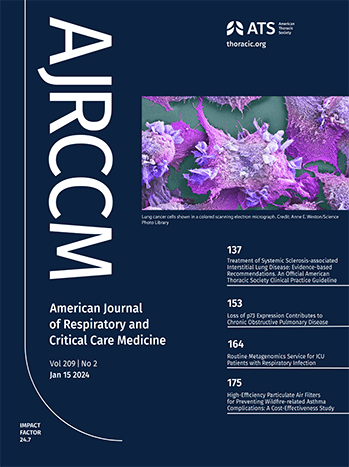美国每年接触空气污染混合物对哮喘住院的影响
IF 19.4
1区 医学
Q1 CRITICAL CARE MEDICINE
American journal of respiratory and critical care medicine
Pub Date : 2025-06-23
DOI:10.1164/rccm.202409-1853oc
引用次数: 0
摘要
理由:空气污染物对所有年龄段的人的哮喘加重都有不利影响。然而,很少有研究对颗粒成分与二氧化氮(NO2)和臭氧(O3)的长期暴露进行研究,以评估它们的混合效应。目的:我们利用加权分位数和(WQS)回归来评估15种颗粒成分的累积效应,包括器官化合物和金属,以及NO2和O3,对0-18岁儿童和19-64岁成人哮喘住院人数的影响。方法:我们对每个年龄组进行了两个单独的WQS模型,权重限制在0-1之间,总和为1,q=10十分位数,100个bootstrap样本。测量方法:从2002年至2016年期间,从美国11个州的州住院数据库中收集了哮喘住院记录。我们还包括温度和美国人口普查的变量,以控制社会经济地位。所有变量被汇总到年度邮政编码水平。主要结果:我们观察到,0 - 18岁儿童和19 - 64岁成人的哮喘住院人数每增加十分位数分别增加10.6% (95%CI: 10.0%,11.2%)和8.0% (95%CI: 7.7%,8.4%)。镍、钒、硫酸盐、硝酸盐、溴和铵对污染物混合物的贡献最大。结论:我们的研究结果表明,长期暴露于污染物混合物与儿童和成人哮喘住院风险增加有关,需要每日测量颗粒成分数据来评估短期暴露。本文章由计算机程序翻译,如有差异,请以英文原文为准。
Association of Annual Exposure to Air Pollution Mixture on Asthma Hospitalizations in the U.S.
Rationale: Air pollutants have adverse effects on asthma exacerbation in people of all ages. However, fewer studies have examined long-term exposure to particle components in conjunction with nitrogen dioxide (NO2) and ozone (O3) to assess their mixture effects. Objectives: We utilized weighted quantile sum (WQS) regression to assess the cumulative effects of 15 particle components including organ compounds and metals, along with NO2 and O3, on counts of inpatient asthma hospitalizations for children ages 0-18 and adults ages 19-64 years. Methods: We conducted two separate WQS models for each age group with weights constrained between 0-1 while summing up to 1, q=10 deciles, and 100 bootstrap samples. Measurements: Inpatient records for asthma hospitalizations were collected from State Inpatient Databases from 11 U.S. states ranging in years from 2002 through 2016. We also included temperature and variables from the U.S. census to control for socio-economic status. All variables were aggregated to the annual ZIP-code level. Main Results: We observed an increase of 10.6% (95%CI: 10.0%,11.2%) and 8.0% (95%CI: 7.7%,8.4%) in the number of asthma inpatient hospitalizations each year for each decile increase of the pollutant mixture in children ages 0 to 18 and adults ages 19 to 64, respectively. Nickel, Vanadium, sulfate, nitrate, Bromine, and ammonium contributed the most weight to the pollutant mixture. Conclusions: Our results indicate that long-term exposure to pollutant mixtures is associated with increased risk of asthma hospitalization in both children and adults, and daily measurements of particle components data is needed to assess short-term exposure.
求助全文
通过发布文献求助,成功后即可免费获取论文全文。
去求助
来源期刊
CiteScore
27.30
自引率
4.50%
发文量
1313
审稿时长
3-6 weeks
期刊介绍:
The American Journal of Respiratory and Critical Care Medicine focuses on human biology and disease, as well as animal studies that contribute to the understanding of pathophysiology and treatment of diseases that affect the respiratory system and critically ill patients. Papers that are solely or predominantly based in cell and molecular biology are published in the companion journal, the American Journal of Respiratory Cell and Molecular Biology. The Journal also seeks to publish clinical trials and outstanding review articles on areas of interest in several forms. The State-of-the-Art review is a treatise usually covering a broad field that brings bench research to the bedside. Shorter reviews are published as Critical Care Perspectives or Pulmonary Perspectives. These are generally focused on a more limited area and advance a concerted opinion about care for a specific process. Concise Clinical Reviews provide an evidence-based synthesis of the literature pertaining to topics of fundamental importance to the practice of pulmonary, critical care, and sleep medicine. Images providing advances or unusual contributions to the field are published as Images in Pulmonary, Critical Care, Sleep Medicine and the Sciences.
A recent trend and future direction of the Journal has been to include debates of a topical nature on issues of importance in pulmonary and critical care medicine and to the membership of the American Thoracic Society. Other recent changes have included encompassing works from the field of critical care medicine and the extension of the editorial governing of journal policy to colleagues outside of the United States of America. The focus and direction of the Journal is to establish an international forum for state-of-the-art respiratory and critical care medicine.

 求助内容:
求助内容: 应助结果提醒方式:
应助结果提醒方式:


